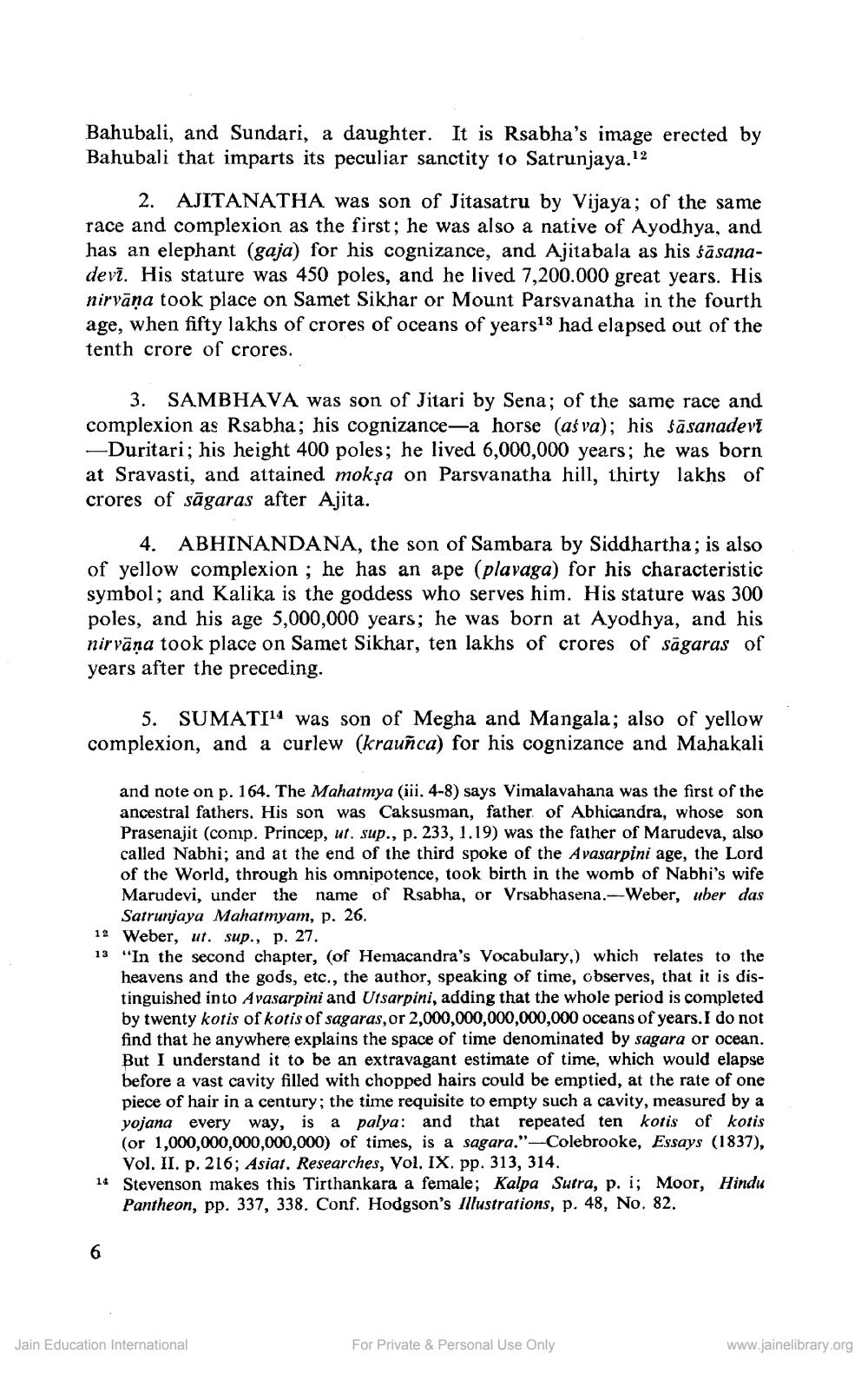________________
Bahubali, and Sundari, a daughter. It is Rsabha's image erected by Bahubali that imparts its peculiar sanctity to Satrunjaya.12
2. AJITANATHA was son of Jitasatru by Vijaya; of the same race and complexion as the first; he was also a native of Ayodhya, and has an elephant (gaja) for his cognizance, and Ajitabala as his śāsanadevi. His stature was 450 poles, and he lived 7,200.000 great years. His nirvāņa took place on Samet Sikhar or Mount Parsvanatha in the fourth age, when fifty lakhs of crores of oceans of years13 had elapsed out of the tenth crore of crores.
3. SAMBHAVA was son of Jitari by Sena; of the same race and complexion as Rsabha; his cognizance-a horse (aśva); his sāsanadevi -Duritari; his height 400 poles; he lived 6,000,000 years; he was born at Sravasti, and attained mokşa on Parsvanatha hill, thirty lakhs of crores of sagaras after Ajita.
4.
ABHINANDANA, the son of Sambara by Siddhartha; is also of yellow complexion; he has an ape (plavaga) for his characteristic symbol; and Kalika is the goddess who serves him. His stature was 300 poles, and his age 5,000,000 years; he was born at Ayodhya, and his nirvana took place on Samet Sikhar, ten lakhs of crores of sagaras of years after the preceding.
5. SUMATI1 was son of Megha and Mangala; also of yellow complexion, and a curlew (krauñca) for his cognizance and Mahakali
12 Weber, ut. sup., p. 27.
13 "In the second chapter, (of Hemacandra's Vocabulary,) which relates to the heavens and the gods, etc., the author, speaking of time, observes, that it is distinguished into Avasarpini and Utsarpini, adding that the whole period is completed by twenty kotis of kotis of sagaras, or 2,000,000,000,000,000 oceans of years. I do not find that he anywhere explains the space of time denominated by sagara or ocean. But I understand it to be an extravagant estimate of time, which would elapse before a vast cavity filled with chopped hairs could be emptied, at the rate of one piece of hair in a century; the time requisite to empty such a cavity, measured by a yojana every way, is a palya: and that repeated ten kotis of kotis (or 1,000,000,000,000,000) of times, is a sagara."-Colebrooke, Essays (1837), Vol. II. p. 216; Asiat. Researches, Vol. IX. pp. 313, 314.
Stevenson makes this Tirthankara a female; Kalpa Sutra, p. i; Moor, Hindu Pantheon, pp. 337, 338. Conf. Hodgson's Illustrations, p. 48, No. 82.
14
and note on p. 164. The Mahatmya (iii. 4-8) says Vimalavahana was the first of the ancestral fathers. His son was Caksusman, father of Abhicandra, whose son Prasenajit (comp. Princep, ut. sup., p. 233, 1.19) was the father of Marudeva, also called Nabhi; and at the end of the third spoke of the Avasarpini age, the Lord of the World, through his omnipotence, took birth in the womb of Nabhi's wife Marudevi, under the name of Rsabha, or Vrsabhasena.--Weber, uber das Satrunjaya Mahatmyam, p. 26.
6
Jain Education International
For Private & Personal Use Only
www.jainelibrary.org




